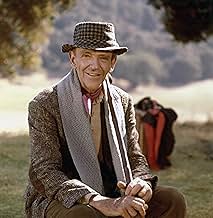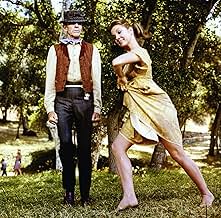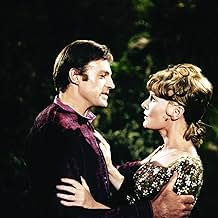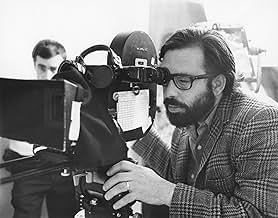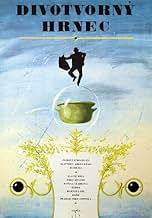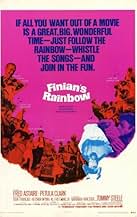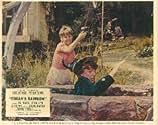PUNTUACIÓN EN IMDb
6,1/10
4,5 mil
TU PUNTUACIÓN
Añade un argumento en tu idiomaAn Irish immigrant and his daughter move into a town in the American South with a magical piece of gold that will change people's lives, including a struggling farmer and African American ci... Leer todoAn Irish immigrant and his daughter move into a town in the American South with a magical piece of gold that will change people's lives, including a struggling farmer and African American citizens threatened by a bigoted politician.An Irish immigrant and his daughter move into a town in the American South with a magical piece of gold that will change people's lives, including a struggling farmer and African American citizens threatened by a bigoted politician.
- Dirección
- Guión
- Reparto principal
- Nominado para 2 premios Óscar
- 1 premio y 9 nominaciones en total
Brenda Arnau
- Sharecropper 'Necessity'
- (sin acreditar)
Charles Carter
- Sharecropper
- (sin acreditar)
Sterling Clark
- Sharecropper
- (sin acreditar)
Robert Cleaves
- Geologist
- (sin acreditar)
Robert Cole
- Sharecropper
- (sin acreditar)
Willie Covan
- Sharecropper
- (sin acreditar)
Evelyn Dutton
- Sharecropper
- (sin acreditar)
Reseñas destacadas
Whimsical is not a word I get to use often, but that's exactly what Finian's Rainbow is. Based on the 1947 stage musical it's part fantasy and part political satire. The plot follows the quintessential Irishman Finian(Fred Astaire in his last full screen role) and his daughter Sharon (Petula Clark) as they basically flee to America with a pot of gold stolen from the leprechaun, Og (Tommy Steele). After an amazing opening credit sequence ("Look To The Rainbow"), they arrive in "Misitucky" which is supposed to be near Fort Knox, to bury the gold in the belief that it will multiply. The small hamlet of Rainbow Valley becomes their home, a kind of Tobacco Road with very poor but very happy hippie-like inhabitants. Here Sharon meets her love interest Woody (Don Francks) Add Keenan Wynn as the villain, Senator Hawkins, a racist Southern stereotype that during the course of the story turns black. Several minor plots weave in and out, creating a rich and unique film. Astaire used to sound stages and carefully planned dance numbers balked at dancing outside in a field and the director, Francis Ford Coppola (an odd choice, but what's done is done) tried his best to meet his demands. Ironically the field sequence, which comes early in the film is beautiful and very well done by the choreographer Hermes Pan, who was subsequently fired from the film. Petula Clark clearly steals the movie. The camera loves her in this and her natural beauty and performance are such a pleasure to watch. Astaire, who was criticized cruelly for his appearance (he was 69 at the time) is as usual charming and no one danced like he did. Francks holds his own and makes a nice compliment to Clark. Tommy Steele's performance rolics between delightful and way too over the top. Beautifully filmed, it does suffer from jarring "this is real, this is fake" scenery but if you just go with it, it's not that bad. The DVD presents Astaire's dance numbers complete and full body (something Astaire always insisted on but was overlooked in the original release) Finian's Rainbow is known now more for many of it's songs than itself as a whole, but it's still very much worth a look, especially if you love musicals.
I first saw this movie as a young girl and developed an instant crush on Tommy Steele. The storyline is very entertaining with a keen sense of humor. It was also great seeing Fred Astaire again - I'm a big fan. This movie has some of the most memorable songs which are still among my favorites, of course many of them featuring Petula Clarke. If you are a fan of musicals and enjoy a bit of the blarney - then this movie will be right up your ally.
The film version of "Finian's Rainbow" was conceived at a time when the public's interest in movie musicals was on the wane; in fact, in light of the poor critical reception accorded "Camelot" the year before, studio head Jack Warner would have been content to pull the plug on what he perceived as another sure-fire disaster. To an extent, his feelings were justified - what had been a daringly provocative look at racial strife in the deep American South as seen through the eyes of a scheming Irishman and his less-than-supportive daughter when it debuted on Broadway in 1947 was no longer very pertinent twenty-one years later, and the fairy tale aspects of the plot - which included the hyperactive antics of a leprechaun intent on retrieving his "borrowed" pot of gold - were going to be a hard sell in 1968. The score, although exquisitely timeless and highly recognizable, was old-fashioned in its theatricality and not likely to result in a best-selling cast album. Furthermore, directing the project was a virtual unknown, a "hippie" from northern California named Francis Ford Coppola, with only one prior film - a non-musical - to his credit. Given the odds the movie was doomed, Warner basically maintained a "hands-off, don't-ask, don't-tell" policy and simply hoped for the best.
The end result may not have been the "best", but it is considerably better than most critics described it upon its release. The overlong book, with several insignificant sub-plots, could have used some judicious trimming. Tommy Steele's performance as Og, the slowly-turning-into-a-human leprechaun, is frantically overblown. The film's editing is criminal in that Fred Astaire's feet are often unseen in his dance routines. And the attempt to blend reality and make-believe results in an awkwardly uneven balance of the two - Coppola would have been far more successful had he decided to emphasize the whimsical and play down the outdated political aspects of the story. But for all these shortcomings, "Finian's Rainbow" - from its spectacular opening credits to its nicely staged farewell to Finian - almost a goodbye to Astaire himself, for whom this would be his last dancing role - is pleasant entertainment, buoyed by its familiar score and anchored by the presence of Petula Clark, whose delightfully fresh and sweetly seductive performance is the true gold to be discovered here. At the time known in the States as the pop singer responsible for the mega-hit "Downtown", Clark drew on her previous experience as an actress in mostly grade-B British films and developed a character whose acceptance of a leprechaun hiding in the backyard well is as easily believed as her skepticism regarding her father's plot to multiply his borrowed gold by burying it in the shadows of Fort Knox and her fiancé's plans to grow mentholated tobacco. The Arlen/Harburg score - including such standards as "How Are Things in Glocca Morra?" and "Look to the Rainbow" - could well have been composed specifically for her voice, which wraps itself around each note with a hint of a brogue and - in the case of "Old Devil Moon" - a raw sensuality suggesting the woman inside the sweet Irish colleen. Deservedly, Clark was nominated for a Best Actress Golden Globe for her portrayal of Sharon McLonergan, and if for nothing else, her performance makes "Finian's Rainbow" definitely worth a look-see.
The end result may not have been the "best", but it is considerably better than most critics described it upon its release. The overlong book, with several insignificant sub-plots, could have used some judicious trimming. Tommy Steele's performance as Og, the slowly-turning-into-a-human leprechaun, is frantically overblown. The film's editing is criminal in that Fred Astaire's feet are often unseen in his dance routines. And the attempt to blend reality and make-believe results in an awkwardly uneven balance of the two - Coppola would have been far more successful had he decided to emphasize the whimsical and play down the outdated political aspects of the story. But for all these shortcomings, "Finian's Rainbow" - from its spectacular opening credits to its nicely staged farewell to Finian - almost a goodbye to Astaire himself, for whom this would be his last dancing role - is pleasant entertainment, buoyed by its familiar score and anchored by the presence of Petula Clark, whose delightfully fresh and sweetly seductive performance is the true gold to be discovered here. At the time known in the States as the pop singer responsible for the mega-hit "Downtown", Clark drew on her previous experience as an actress in mostly grade-B British films and developed a character whose acceptance of a leprechaun hiding in the backyard well is as easily believed as her skepticism regarding her father's plot to multiply his borrowed gold by burying it in the shadows of Fort Knox and her fiancé's plans to grow mentholated tobacco. The Arlen/Harburg score - including such standards as "How Are Things in Glocca Morra?" and "Look to the Rainbow" - could well have been composed specifically for her voice, which wraps itself around each note with a hint of a brogue and - in the case of "Old Devil Moon" - a raw sensuality suggesting the woman inside the sweet Irish colleen. Deservedly, Clark was nominated for a Best Actress Golden Globe for her portrayal of Sharon McLonergan, and if for nothing else, her performance makes "Finian's Rainbow" definitely worth a look-see.
First, FINIAN'S RAINBOW does not take place in Tennessee. The movie only mentions Rainbow Valley, but onstage the valley is in Missitucky, home to Fort Knox and the gold depository that was thankfully saved by James Bond in later (for the movie, earlier) years.
The movie's flaws lie not so much in the updating to 1968 as in the eyes of today's viewers. We have sadly grown used to movies that are paced much faster than this one. As a result, those too young to have grown up with older movies will consider FINIAN'S RAINBOW very slow and overlong.
Fundamentally, though, FINIAN'S RAINBOW suffers the same afflictions all stage musicals suffer when transcribed to the big screen: Loss of intimacy. Hollywood always makes stage musicals 'way too big. They think musicals have to take place all over the continent. Oddly, a single stage worked for the play, and still does. (Possibly the rare exception to this is THE MUSIC MAN which was "opened up" only enough, not too much.) All movies are of their times, especially movie musicals. Accept that and enjoy FINIAN'S RAINBOW's wonderful score and excellent performances by the entire cast.
The movie's flaws lie not so much in the updating to 1968 as in the eyes of today's viewers. We have sadly grown used to movies that are paced much faster than this one. As a result, those too young to have grown up with older movies will consider FINIAN'S RAINBOW very slow and overlong.
Fundamentally, though, FINIAN'S RAINBOW suffers the same afflictions all stage musicals suffer when transcribed to the big screen: Loss of intimacy. Hollywood always makes stage musicals 'way too big. They think musicals have to take place all over the continent. Oddly, a single stage worked for the play, and still does. (Possibly the rare exception to this is THE MUSIC MAN which was "opened up" only enough, not too much.) All movies are of their times, especially movie musicals. Accept that and enjoy FINIAN'S RAINBOW's wonderful score and excellent performances by the entire cast.
This was Fred Astaire's last full-blown musical movie ("That's Entertainment II" is not counted). The original play, written back in the 1930's, dealt more with the organization of a union by a bunch of poor sharecroppers. But by the time this movie was finally set to be made, unions were no longer the "hot topic", thus the racism angle was embellished. Plot aside, which isn't difficult, the basis of the story is that Finian McGlonnagen (Fred Astaire) has stolen a pot of gold from Og the leprechaun (played to perfection by Tommy Steele) and has plans to bury it near Fort Knox, thinking that the "magical properties" in the ground there will make more gold for him. Not exactly Pulitzer stuff here, but an enjoyable movie. A great vehicle for Keenan Wynn, showing why he was the best character actor of his day, and Tommy Steele, who disappeared from American movie screens far too soon. Great music; Good movie.
¿Sabías que...?
- CuriosidadesMany, including Fred Astaire, blamed director Francis Ford Coppola for cutting off Astaire's feet during filming of his dancing scenes, but it was Warner Bros. who decided, after the filming had been completed in 35mm, to convert the film to the wider 70mm and promote it as a "reserved-ticket roadshow attraction." This was achieved by cropping off the tops and bottoms of the film frame, including some shots of Astaire's footwork.
- PifiasIn the song "Old Devil Moon" as Woody and Sharon dance through the stream, Woody has bare feet and his hands are in Sharon's. In the next shot, he has his shoes on, and it even looks as if his trousers are dry.
- Versiones alternativasFilmed in 35mm, Warners decided afterwards to promote it as a "reserved-ticket roadshow attraction" and converted it to 70mm, creating a wider-screen aspect ratio by cropping away the tops and bottoms of the images, and cropping away Fred Astaire's feet during some of his dance scenes. Restored versions show the original aspect ratio.
- ConexionesEdited into El chico que conquistó Hollywood (2002)
- Banda sonoraLook To The Rainbow / How Are Things In Glocca Morra?
(1946) (uncredited)
(Main Title)
Played during the opening credits
Lyrics by E.Y. Harburg
Music by Burton Lane
Sung by Petula Clark ("Rainbow") and played by the Warner Bros.
Orchestra ("Glocca Morra") conducted by Ray Heindorf
Selecciones populares
Inicia sesión para calificar y añadir a tu lista para recibir recomendaciones personalizadas
- How long is Finian's Rainbow?Con tecnología de Alexa
Detalles
- Fecha de lanzamiento
- País de origen
- Idiomas
- Títulos en diferentes países
- La vall de l'arc iris
- Localizaciones del rodaje
- Empresa productora
- Ver más compañías en los créditos en IMDbPro
Taquilla
- Presupuesto
- 3.500.000 US$ (estimación)
- Duración2 horas 21 minutos
- Relación de aspecto
- 2.39 : 1
Contribuir a esta página
Sugerir un cambio o añadir el contenido que falta

Principal laguna de datos
By what name was El valle del arco iris (1968) officially released in India in English?
Responde

